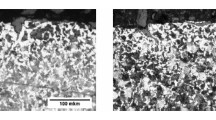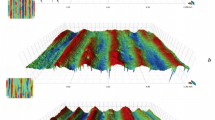Conclusions
The effect of surface hardening by cold working depends mainly on the stability of residual compressive stresses. The residual stresses decrease greatly in the first hours at elevated temperature and then change slowly. The time that the effect of surface hardening is retained in heat-resisting alloys can be determined approximately — from the decoration of the structure with dislocations — by metallographic examination.
Similar content being viewed by others
Literature cited
G. V. Makhanek, S. N. Petrova, and V. D. Sadovskii, in: Properties and Applications of Heat-Resisting Alloys [in Russian], Nauka, Moscow (1966).
Additional information
Translated from Metallovedenie i Termicheskaya Obrabotka Metallov, No. 2, pp. 56–58, February, 1971.
Rights and permissions
About this article
Cite this article
Poloskin, Y.V., Davykova, V.V. The surface layer of surface-hardened parts of heat-resisting alloys. Met Sci Heat Treat 13, 144–146 (1971). https://doi.org/10.1007/BF00650934
Issue Date:
DOI: https://doi.org/10.1007/BF00650934




